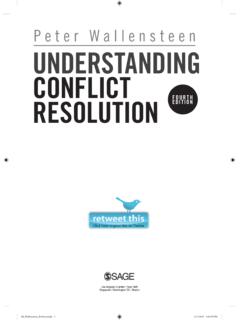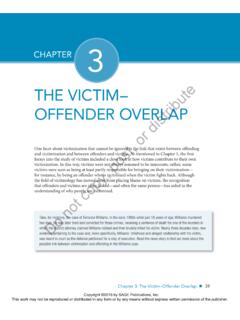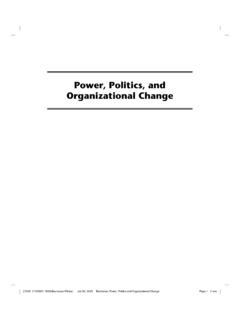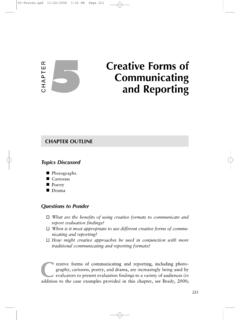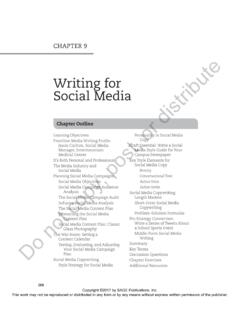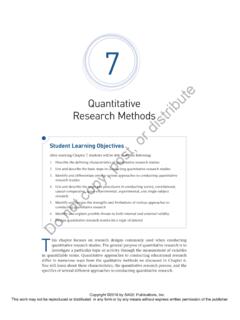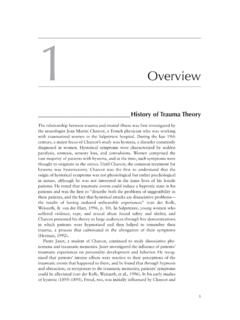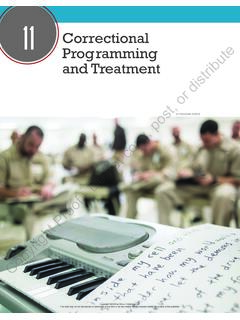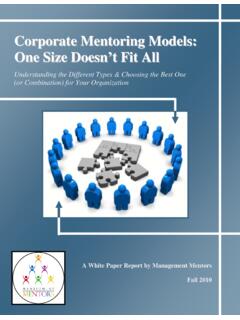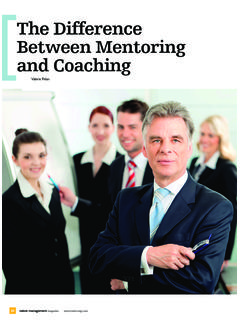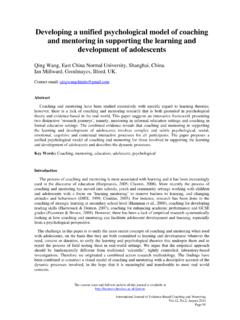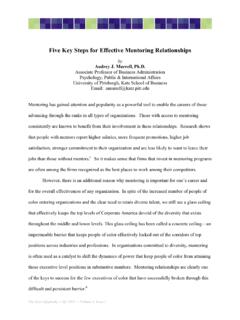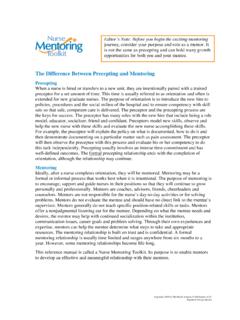Transcription of What is Mentoring and What is Coaching?
1 1 what is Mentoring and what is Coaching? This chapter covers the historical narratives of coaching and Mentoring and links these to modern day practice and current arguments. It also explores the historical meanings and considers what coaching and men-toring are for. It is clear that there have been changes in meaning for the terms coaching and Mentoring over time. This observation in turn raises truth issues. I discuss these by making use of a speculative uni-fied heuristic framework for coaching and Mentoring at the end of the I get into presenting a brief history of coaching and Mentoring , I think it is important to be mindful of what historical research could become.
2 Friedrich Nietzsche s essay, The Use and Abuse of History (1873), talked about a malignant historical fever . Nietzsche believed that studying history was potentially a worthless activity, which did not always lead to a good use for historical tradition. He believed that past knowledge should serve both the present and the future but also that history should not become abstract and devoid of the context that gave it life. Social context is a recurrent theme throughout this book! A concept to consider, and one that underpins this book, is that both coaching and Mentoring share a learning and development agenda (see Chapter 5). There are many ways to look at learning. For example: vThe importance of whole person learning (Buber, 1958).
3 VThe conditions for learning, the social context and dialogue (Rogers, 1969; Habermas, 1974; Vygotsky, 1978, 1981, 1985a, b; and Bruner, 1990). vThe importance of experiential learning (Dewey, 1958; Lewin, 1951; Piaget, 1970 and Kolb, 1984). vThe importance of reflection (Argyris & Schon, 1981). vThe importance of purpose (Lyotard, 1984). 830/07/2011 9:56:14 AMWhat is Mentoring and what is coaching ? 9In relation to this purpose for coaching and Mentoring activity, Lyotard s (1984) framework as summarised by Pedler et al. (2005: 62) is helpful here: Speculative: knowledge for its own sake, concerned with theoretical rigour, unconcerned with : knowledge that helps us overcome oppression and attain the highest human : knowledge that helps action in the world, to resolve problems, to produce better goods and s position suggests that learning has the potential to serve all three purposes.
4 However, arguably, modern life seems to focus far more on per-formative knowledge and this, in my view, creates a problem, placing all sorts of tensions and pressures on people. It also raises ethical issues and we could well ask if the purpose of coaching and or Mentoring varies or is mixed, does the practice and therefore the in use meaning change? These issues are discussed as the book very brief history of mentoringThe first mention of Mentoring in history can be found in Homer s Odyssey. Here Mentor, the Goddess Athene in disguise, takes Odysseus son on a developmental journey in order to maintain the Kingdom of Ithaca and develop a successor to the later on in eighteenth-century Europe there appeared five main publications about Mentoring .
5 First was F n lon s (1651 1715) educa-tional treaties Les Aventures de T l maque; then Louis Antonine de Caraccioli (1723 1803) published Veritable le Mentor ou l education de la noblesse in 1759 and this was translated into English in 1760 to become The true mentor, or, an essay on the education of young people in fashion. In 1793 and 1796, Honoria published three volumes of The Female Mentor. The later authors all based their writing on F n historical works link Mentoring with cognitive development, emotional development, leadership and social integration, all of these being rooted in an experiential learning philosophy. Mentors invited men-tees to participate in and observe situations that they would then discuss.
6 Transition and change are also key elements and Mentoring will involve the older, more experienced, person in supporting and engaging in discus-sions with the younger and often less experienced mentee. Both mentee and mentor would use the experience to facilitate reflection and discussion 930/07/2011 9:56:14 AM10 Studying coaching and Mentoringwith the purpose of gaining an all-round education. It was explicit in these writings that the mentor supported the discussions with reflective and challenging questioning and would tend to hold back from handing out uninvited advice as has been suggested by, for example, Rosinski (2004).more recent historyDaniel Levinson first presented the modern concept of Mentoring in the USA in his (1979) book The Seasons of a Man s Life.
7 This was a sub-stantial longitudinal study of male development. Levinson used the term mentor for someone, often half a generation older, who could help accelerate the development of another in his age-related transi-tions. He suggested that Mentoring could reduce these age transitions from an average of seven to three years. This very quickly became the catalyst for a rapid growth in Mentoring that would focus on an accel-erated career progression in the USA. In Passages: Predictable Crises of Adult Life (1976), Gail Sheehy dis-cussed adult development mainly from a female perspective. At that time, she noted that Mentoring relationships were not so common among women.
8 However some twenty years later, in her revised edition, New Passages: Mapping Your Life Across Time (1996), she added developmen-tal maps on both male and female development and noted that Mentoring had become more common among women. She also noted a substantial social change in attitudes in both women s and men s lives in developed economies since her first edition had appeared in 1976. These changes were with regard to attitudes towards work, careers and equality. Still in the USA, Kathy Kram has produced much good quality research on Mentoring . This is discussed throughout the book but, in my view, her most significant contribution to the Mentoring literature has been her statement that Mentoring activity performs a psychosocial function (1983: 616); the mentee is socialised into a specific social con-text and develops self-insight and psychological wellbeing.
9 More generally within the Mentoring literature there is a discussion around the psychological impact of Mentoring . For example, Zaleznik (1977: 76) writes psychological biographies of gifted people repeatedly demonstrate the important part a mentor plays in developing an individ-ual . He argues that leadership ability is developed through these intense and often intuitive relationships which have the affect of encouraging the emotional relationship leaders need if they are to survive (p. 78). The theme of emotional development within Mentoring is common and has its origins in history. Berman and West (2008: 744) show that Mentoring activity increases the accurate awareness about one s emotional 1030/07/2011 9:56:14 AMWhat is Mentoring and what is coaching ?
10 11intelligence skills and many writers (Clawson, 1996; Levinson et al., 1978; Mullen, 1994; Smith, 1990; Zey, 1984) link a mentor s unconscious motivation to Erikson s (1978) psychological concept of generativity . McAuley (2003) employs the psychological concepts of transference and countertransference in order to provide a deeper insight into the power dynamics that may be at play between mentor and mentee relationships. Garvey (2006) shows in two Mentoring case studies that the intention for Mentoring is not therapy but its affect can be therapeutic . In these cases, he links mentees development to Levinson et al. s (1978) frame-work of age-related transition and Jung s (1958) psychological concept of individuation.

